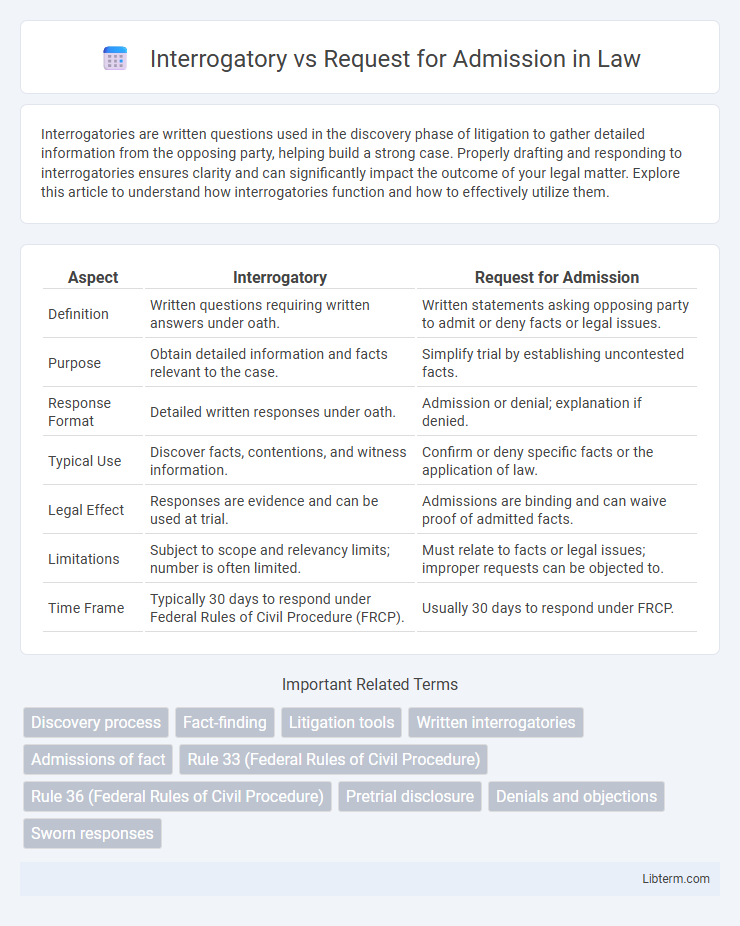Interrogatories are written questions used in the discovery phase of litigation to gather detailed information from the opposing party, helping build a strong case. Properly drafting and responding to interrogatories ensures clarity and can significantly impact the outcome of your legal matter. Explore this article to understand how interrogatories function and how to effectively utilize them.
Table of Comparison
| Aspect | Interrogatory | Request for Admission |
|---|---|---|
| Definition | Written questions requiring written answers under oath. | Written statements asking opposing party to admit or deny facts or legal issues. |
| Purpose | Obtain detailed information and facts relevant to the case. | Simplify trial by establishing uncontested facts. |
| Response Format | Detailed written responses under oath. | Admission or denial; explanation if denied. |
| Typical Use | Discover facts, contentions, and witness information. | Confirm or deny specific facts or the application of law. |
| Legal Effect | Responses are evidence and can be used at trial. | Admissions are binding and can waive proof of admitted facts. |
| Limitations | Subject to scope and relevancy limits; number is often limited. | Must relate to facts or legal issues; improper requests can be objected to. |
| Time Frame | Typically 30 days to respond under Federal Rules of Civil Procedure (FRCP). | Usually 30 days to respond under FRCP. |
Introduction to Interrogatories and Requests for Admission
Interrogatories are written questions sent by one party to another in a lawsuit, requiring detailed, sworn written answers relevant to the case. Requests for Admission consist of statements sent for the opposing party to admit or deny, streamlining the issues by confirming facts or the authenticity of documents. Both tools serve to narrow the scope of the dispute, aid in evidence gathering, and facilitate case preparation ahead of trial.
Defining Interrogatories
Interrogatories are written questions served by one party to another in a lawsuit, designed to gather detailed information relevant to the case. They must be answered in writing and under oath within a specified timeframe, providing a clear record of facts and evidence. This discovery tool contrasts with Requests for Admission, which aim to establish the truth of specific statements to streamline trial issues.
What Are Requests for Admission?
Requests for Admission are formal legal tools used in civil litigation to streamline the trial process by having one party ask the other to admit the truth of specific facts or the authenticity of documents. These requests help narrow down the disputed issues by establishing uncontested facts, which can significantly reduce the time and cost of a trial. Courts often enforce strict deadlines for responding, and failure to respond may result in automatic admission, impacting case strategy.
Key Differences Between Interrogatories and Requests for Admission
Interrogatories require detailed written answers to specific questions under oath, often used for fact-finding and clarifying issues in a case. Requests for Admission seek to establish the truth of certain facts or the authenticity of documents, simplifying trial by limiting what must be proven. The primary difference lies in interrogatories' demand for explanations versus requests for admission's goal to confirm or deny specific statements.
Legal Purpose and Objectives of Each Discovery Tool
Interrogatories are written questions served during discovery to obtain detailed factual information, ensuring parties disclose relevant evidence early and clarify issues before trial. Requests for Admission seek to establish undisputed facts by requiring parties to admit or deny specific statements, streamlining the trial process and reducing the scope of contested matters. Both tools aim to promote efficiency and transparency, with interrogatories uncovering substantive details and requests for admission focusing on narrowing factual disputes.
When to Use Interrogatories in Litigation
Interrogatories are best used during the discovery phase of litigation when parties need detailed, written responses to specific questions that clarify facts, establish evidence, or narrow the issues for trial. They are effective in obtaining admissions, identifying witnesses, or understanding an opponent's claims and defenses in a structured format. Unlike requests for admission, which seek to confirm or deny factual statements, interrogatories solicit comprehensive explanations and information essential for case preparation.
When to Use Requests for Admission
Requests for Admission are best used during the discovery phase when the goal is to simplify litigation by establishing undisputed facts early. They are particularly effective for confirming facts, the authenticity of documents, or the application of law to eliminate the need for proving these elements at trial. Utilizing Requests for Admission strategically can reduce trial time and costs by narrowing the issues that actually need to be contested.
Drafting Effective Interrogatories and Requests for Admission
Drafting effective interrogatories requires precise, clear questions targeting specific facts to elicit detailed, relevant information without overburdening the responding party. Requests for admission should be crafted to narrow the issues by seeking straightforward, easily admitted or denied statements, simplifying trial preparation and evidentiary disputes. Both tools must avoid ambiguous language and focus on concise, legally significant assertions to optimize discovery efficiency and case strategy.
Common Pitfalls and Best Practices
Interrogatories and Requests for Admission both serve key roles in discovery but often encounter pitfalls such as vague questions in interrogatories and overly broad or ambiguous admissions requests. To avoid these issues, draft clear, concise, and specific interrogatories tailored to uncover facts, and ensure Requests for Admission are narrowly focused to confirm undisputed facts efficiently. Implementing precise language and anticipating potential objections enhances the effectiveness and admissibility of responses during litigation.
Conclusion: Choosing the Right Discovery Tool
Interrogatories provide detailed, written questions that elicit comprehensive information from the opposing party, whereas Requests for Admission streamline the litigation process by securing admissions on specific facts or the authenticity of documents. Selecting the appropriate discovery tool depends on the complexity of information sought and the need to narrow issues for trial, with interrogatories uncovering nuanced details and requests for admission focusing on establishing uncontested facts. Effective litigation strategy often incorporates both methods to efficiently gather evidence and strengthen case positioning.
Interrogatory Infographic

 libterm.com
libterm.com